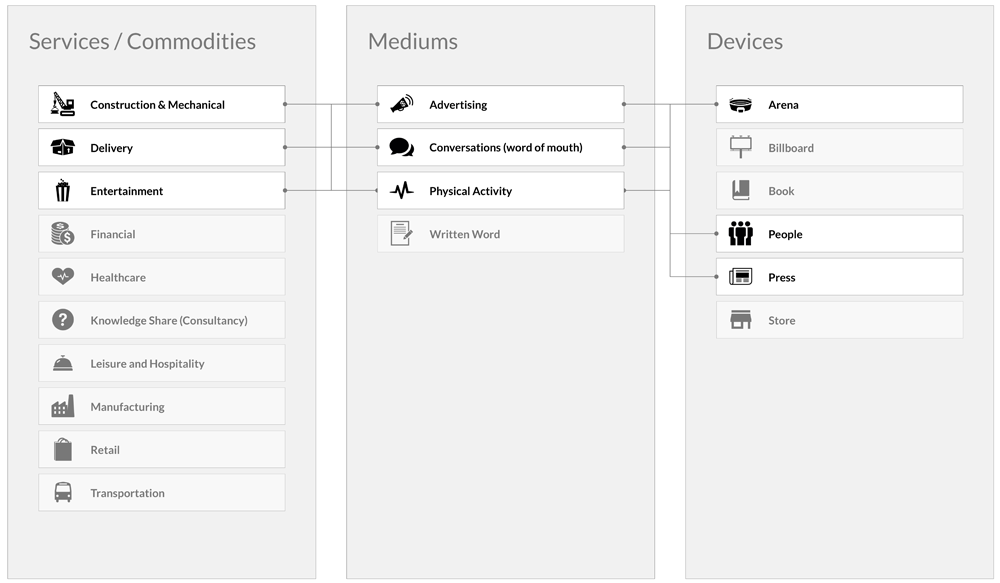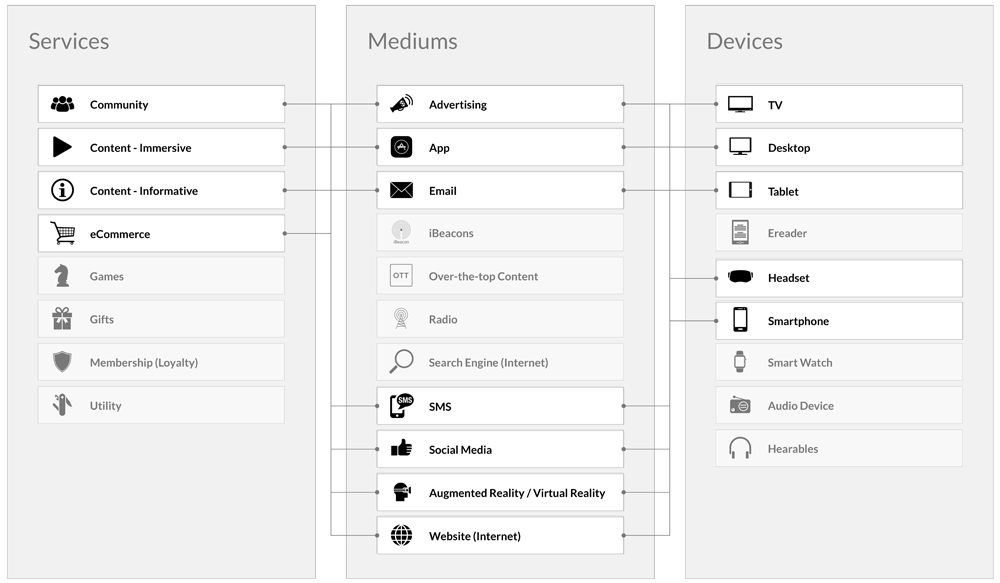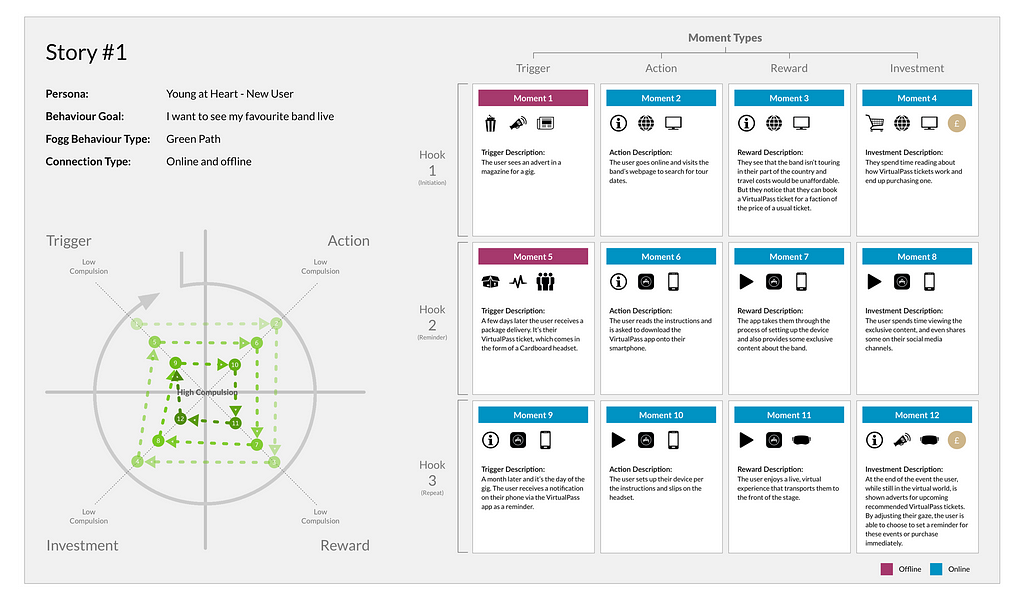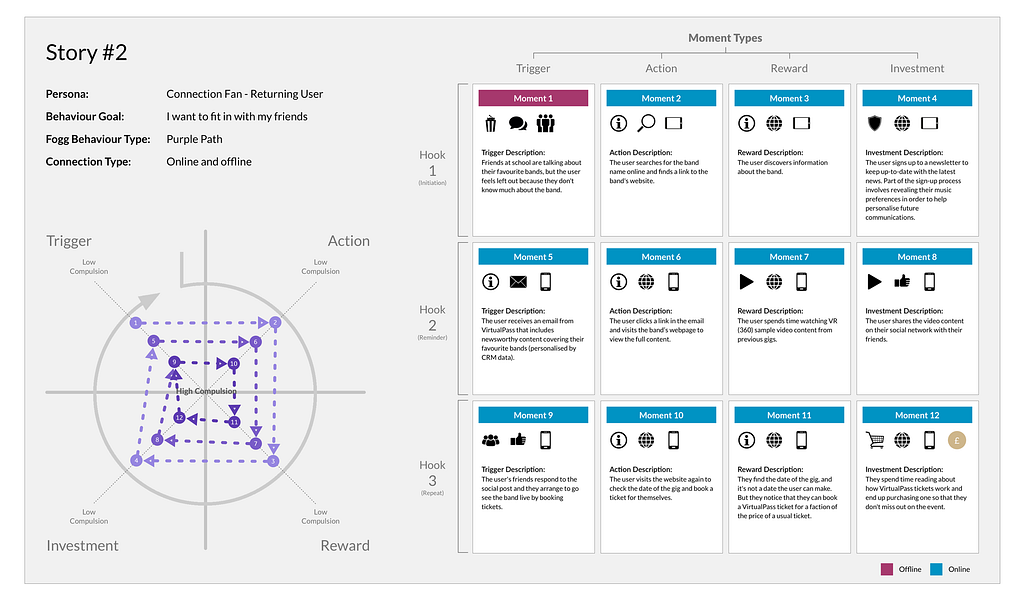
By Steve McCarthy
In September 2016 I posted an article on a new method for defining user stories and journeys called Storyframing. More specifically it was a method for…
Designing a digital service or product around distinct user behaviour, helping to ensure user adoption and repeat use are front of mind from the outset of a project.
The process was born out of a frustration for not having a readily available framework that considered behaviour change or long term user engagement in detail.
Feedback from the UX community was positive and some of the readers suggested that I share more information on the Storyframing method…
An idea…
Not everyone gets to see their favourite bands in concert.
Obstacles like ticket costs, age limits, and location can make it difficult for fans to experience live music.
But what if we could transport customers to the front of the stage using VR? What if the number of tickets a band could sell wasn’t constrained by the capacity of a stadium?

VirtualPass (a fictional company) is a startup who have had that very idea. They now want to better understand how their service is best placed to create compelling stories for their potential customers.
Time to start storyframing…
1. Categorise your users
VirtualPass* have two core user personas they want to target:
i. Young at Heart — New Users
ii. Connection Fan — Returning Users
2. Define your moment ingredients
Following a stakeholder workshop with the brand we identified the following as viable Services (S), Mediums (M), and Devices (D) at their disposal:


3. Understand moment types
This is an easy step. We’ve storyframed before so we know that there are 4 types of Moments (m):
- Trigger (Tm) moments
- Action (Am) moments
- Reward (Rm) moments
- Investment (Im) moments
We just need to keep this in mind for when we start to craft our stories.
4. Set behaviour goals
By returning to the brand’s pre-existing persona work we can draw from actual user sentiment in order to identify their behaviour goals. If the brand hadn’t conducted this type of research then this is something we would recommend before continuing. Otherwise we risk designing a product that nobody wants.
‘Young at Heart’ Persona
This user is between 35–50. They love live music — in fact they used to go to gigs all the time when they were younger — but the chores of everyday life have taken over and finding the time and money to make it to see their favourite band is near impossible. They find solace in technology such as Spotify and Apple Music that allows them to quickly download or stream music — keeping them up-to-date — but they miss the visual ‘experience’ of seeing a band performing live.
User Type: New
Behaviour Goal: I want to see my favourite band live
Fogg Behaviour Type: Green Path (new behaviour)
Connection Type: Online and offline
‘Connection Fan’ Persona
This user is between 12–21. Their music tastes are largely dictated by their friends. They are relatively new to live music, and because of their age often have to be chaperoned at gigs. Their experiences of live music are largely contained to user-generated video content that they share on social networks. Sometimes the gigs are too expensive for them to afford, which means they don’t always get to go and the fear of missing out (FOMO) on a social event can be frustrating.
User Type: Returning
Behaviour Goal: I want to fit in with my friends
Fogg Behaviour Type: Purple Path (familiar behaviour)
Connection Type: Online and offline
5. Craft your stories
Taking all of the above into consideration we crafted the following stories for VirtualPass. These are just two examples, and we’d usually expect to create at least three stories per persona.


By following the storyframing process we have now:
- Identified the viable Services (S), Mediums (M), and Devices (D) at the brand’s disposal (online and offline)
- Organised those ingredients into Moments (m) that ensure there is always an investment from the user which will bring them back to the brand again
- Ordered these Moments (m) into a logical narrative that aims to achieve a specific behaviour goal
The brand has benefited by:
- Having a clear view of the ideal user journey
- Seeing how and where customers could interact with their brand
- Identifying the gaps between the desired customer experience and the one actually received
- Highlighting development priorities and areas of focus e.g. there’s no point developing a smart watch app if users aren’t using them in our stories
- Allowing the brand to concentrate efforts and expenditure on what matters most to maximise effectiveness
Hopefully this has helped further explain the storyframing process. You can download the icons used for the ingredients here. I welcome feedback from the UX community and encourage you to use this methodology when developing products/services.
The storyframing framework was developed while working at Brandwidth.
If you’ve found this article useful and want to know more about how you can use the storyframing framework to increase the success of your (or your client’s) products and services then write a comment below and I’ll get back to you.
What is Storyframing? ← P R E V I O U S
N E X T → Has ‘user’ become an outdated term?
Storyframing: What we want users to do was originally published in uxdesign.cc – User Experience Design on Medium, where people are continuing the conversation by highlighting and responding to this story.
from uxdesign.cc – User Experience Design – Medium https://uxdesign.cc/storyframing-what-we-want-users-to-do-8ef871903867?source=rss—-138adf9c44c—4
